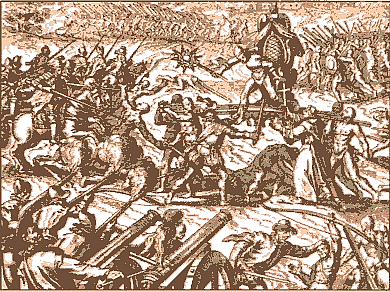 |
| Conquest of Northwestern South America |
Before the Spanish invasions of the early 16th century, the indigenous peoples of the Caribbean littoral of northern South America were divided into a number of polities and a host of ethnolinguistic groups.
Their states and material culture were not as advanced as those in highland Peru or Mexico, so the native peoples of this variegated land had no large cities, used stone tools, produced fine gold work and pottery, and cultivated potatoes, quinoa, maize, beans, squash, and many fruits and vegetables, combined with hunting, gathering, and fishing. Native populations are estimated to have been in the millions.
One major population center was in the mountain valleys surrounding present-day Bogotá and extending northeast to the coast near present-day Caracas, the homeland of the Muisca or Chibcha peoples, divided into two large confederations. Other villages, settlements, and communities were spread across the region.
  |
The first European contacts with the region came in 1498 when the third expedition of Christopher Columbus skirted the Venezuelan coast. Over the next two decades, Spanish encounters with the local inhabitants consisted of slave raiding and trading expeditions.
The most important consequence of these early encounters was the implantation of deadly European diseases, which rapidly spread west across Colombia and south into the Andes, causing millions of deaths. By the late 1520s, only a few small permanent settlements had been established between the isthmus of Panama and the mouth of the Orinoco River.
In 1528, Charles V contracted with the Wesler banking house of Ausburg for exploration and settlement of the mountainous region of Venezuela and Colombia. After six expeditions inland, the Wesler incursions found no large cities and very little gold.
Nor did they found any towns, while committing many abuses against the natives. In 1548, the Crown cancelled the contract. In 1530, two years after the Wesler agreement, Diego de Ordas, a former captain of Hernán Cortés, received royal authority to explore the Orinoco Basin, whose mouth lay far to the east of the northern Andes. His expedition of some 600 Spaniards also ended in failure.
In 1535, the discovery of golden objects in native tombs prompted further Spanish interest in the region. Several expeditions followed. The most important was led by Gonzalo Jiménez de Quesada, who in 1536 led his 800-strong force up the Magdalena Valley.
By the time he reached the Chibcha settlements, fewer than 200 of his men survived. Subjugation of the zone took more than a year, as native arrows, slings, and clubs once again proved no match for Spanish horses and steel.
Combining warfare and threats with diplomacy and subterfuge, by 1538 Quesada had largely subdued the Chibcha. The loot proved substantial: some 150,000 pesos of gold, hundreds of emeralds, and other precious objects, divided unevenly among Quesada and his men, the governor of Santa Marta, and the Crown.
Toward the end of the Chibcha campaign, two other expeditions converged on the zone: a Wesler-financed expedition led by Nikolaus Federmann and the remnant of the Andean force of Sebastián de Benalcázar, leader of the Quito expedition under Francisco Pizarro in the Conquest of Peru.
Quesada called the region New Granada and founded a town, Santa Fé de Bogotá, on the site of the former Chibcha capital. Meanwhile, most of the interior lay unexplored. A final series of expeditions took place in the 1540s and 1550s, most in search of the mythical kingdom of El Dorado.
The year 1541 saw three such efforts: one headed by Gonzalo Pizarro, another by Hernán Pérez de Quesada (brother of Gonzalo Jiménez de Quesada), and a third by Philip von Hutten, the last of the Welser explorers.
Benalcázar followed in 1543. All ended in failure. One result of this string of failed expeditions was the journey and journal of Francisco de Orellana, one of Gonzalo Pizarro’s lieutenants, who floated down the Amazon River to its mouth. A final expedition in 1559 under Pedro de Ursúa ended in mutiny and a failed rebellion against the Spanish Crown under commoner Lope de Aguirre.
Caracas was founded in 1567, while the region did not become a viceroyalty (the largest colonial-era political jurisdiction, as in Mexico and Peru) until the Crown created the Viceroyalty of New Granada, with its capital at Santa Fe de Bogotá, in 1739.
Throughout the colonial period, Spanish, Dutch, and English settlements in the region were limited mainly to the Caribbean littoral and the northwestern Andes, while vast areas of the interior remained terra incognita and outside the orbit of European control.